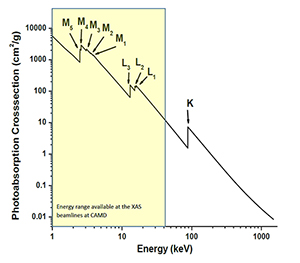X-ray Absorption Spectroscopy (XAS)
X-ray Absorption Spectroscopy (XAS) is a technique to analyze the elemental properties of a material. It also helps to understand the chemistry of an element on a molecular level and further whether the material is amorphous or crystalline. XAS has significant advantages compared to other methods since it is element specific, no high vacuum required, and no specific sample preparation is required. The XAS experiments can be either static (before and/or after reactions) or dynamic (in situ reactions), while the materials for the measurements can be in a solid, liquid, or gaseous state.

XAS of Pb showing K, L, and M edges. The shaded yellow energy range is accessible at CAMD
Beamlines for XAS
LEXAS (low energy: between 1.7 and 6.5 keV)
DCM (between 1 and 6 keV)
HEXAS (high energy: between 4.5 and 25 keV)
VLSPGM (0.2 – 1.2 keV)
Typical crystals at LEXAS or DCM are InSb(111) for Si, P, S, and Ca - for HEXAS are Ge220, Ge422, Ge531 and the VLSPGM is a ruled diffraction grating.
Applications
XAS is a technique with many application. Examples of research conductted at CAMD include:
- Environmental Sciences
- Chemical Engineering
- Geosciences
- Biology
- Material science (Chemistry, Physics)
- Nanomaterials
- Art and Archaeology
- CAMD specialty: Low energy XAS